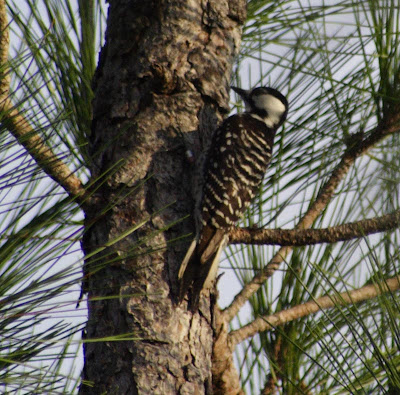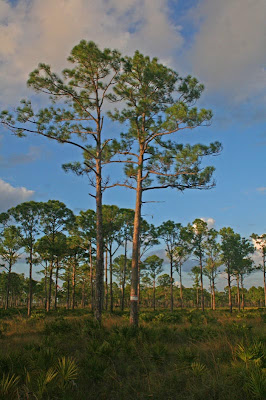 One of the first birds sighted was an actively hunting Tri-Colored Heron
One of the first birds sighted was an actively hunting Tri-Colored Heron This Spotted Sandpiper walked by
This Spotted Sandpiper walked by A nice shot of Roseate Spoonbills
A nice shot of Roseate Spoonbills Semi-Palmated Plover
Semi-Palmated Plover Incoming!
Incoming!
Flyover White Pelican




A nice shot of a hunting Snowy Egret

Our lifer Yellow Crowned Night Heron
Another nice view of a Roseate Spoonbill
Yellow Rumped Warbler at one of the pulloffs on the loop drive


After Ding Darling, we stopped by Sanibel-Captiva Conservation Foundation. Unfortunately, this Nature Center was closed for the Holidays. It looked interesting though, and well worth a vsit next time! Despite the visit being short, we saw a good number of birds in the parking lot! This included RED-BELLIED WOODPECKER, DOWNY WOODPECKER, PALM WARBLER, YELLOW RUMPED WARBLER, and YELLOW BELLIED SAPSUCKER. There were a lot of little warblers, so there could have been other species present, but the flock moved on.

Yellow-Rumped Warbler, also at SCCF
We decided to hit some of the beaches on Sanibel Island, after a brief stop at a deli for lunch. We first tried Lighthouse Beach. This beach was quite croweded, but a walk a ways led to quieter areas. There were allegedly many Pileated here, but we only found a RED-BELLIED WOODPECKER, and an OSPREY. Further down, by a fishing pier, there were BROWN PELICAN, ROYAL TERN, and LAUGHING GULL. The hunting antics of the young Pelicans were quite entertaining!







Our next stop was Bowman's Beach, further north on the island. This spot was a little bit more remote and interesting. On the way, between Bowman's and Ding Darling we saw a flock of TREE SWALLOWS foraging that must have numbered in the tens of thousands! On the walk to the beach itself we had LITTLE BLUE HERON. Walking along the parts of the beach were there were less people, we had WILLET and SANDERLING foraging (and catching little critters). Flyovers featured OSPREY, and MAGNIFICENT FRIGATEBIRD (two different birds). Terns would fly by as well, FORSTERS TERN for sure, and perhaps a few other species. We also saw several LAUGHING GULLS. Upon leaving the beach, the ever present PALM WARBLER, but also MOURNING DOVE, and COMMON GROUND DOVE.

Bowman's Beach at Sanibel Island

Another shot of Bowman's Beach at Sanibel Island

Flyover Magnificent Frigatebird on Bowman's Beach

Sanderlings foraging on Bowman's Beach

Flyover Osprey at Bowman's Beach
 Foresters Tern flyover (odd because the legs don't appear orange..)
Foresters Tern flyover (odd because the legs don't appear orange..) 




 A flyby of some Sanderlings on Bunche Beach
A flyby of some Sanderlings on Bunche Beach

Before leaving Sanibel Island, we decided to give Ding Darling one more try. We got some more cool photos! (See below) The tide was higher, so viewing conditions were not as favorable. We did manage to see two birds that were missed in the morning drive: EASTERN PHOEBE, and GREEN HERON.

A cool look at a Tricolored Heron at Ding Darling

I thought this was a cool shot, contrasting the size of the pelicans and the pipers

Mostly Willet (with some pelicans, gulls, egrets, and teal in the background)

One of the groups of pipers at Ding Darling. I think they are mostly Dunlin (with the help of some better at pipers than I!)

At least one Willet has joined the smaller pipers (Dunlin?) here

More pipers at Ding Darling. IDs anyone?

A very sharp eyed young birder discovered this Green Heron hunting in a Mangrove bush for us!

Palm Warbler at Ding Darling NWR

Eastern Phoebe at Ding Darling NWR

Nice scenery at Ding Darling
Since we had a little light left upon leaving Sanibel, we thought about adding a birding stop on the drive north to Tampa (where we would fly home very early on December 31). We had thought about the "Celery Fields" in Sarasota for Black Bellied Whistling Ducks, or the Oscar Scherer State Park near Sarasota for Florida Scrub Jay. Unfortunately, there was a traffic delay leaving the Island on the Causeway, and driving through Fort Myers traffic took forever to get to I-75. This cut further into daylight, and made us search locations further south, and hence closer. Our excellent ABA Birding Florida book mentioned Babbcock-Webb WMA near Punta Gorda as being a good spot for the endangered Red-Cockaded Woodpecker. We tried that and found the woodpeckers easily, so it turns out the delay really worked in our favor, giving us a chance to see these really cool birds! (More on the endangered Red Cockaded Woodpecker). There are several dirt roads through the preferred pine habitat where the woodpeckers live, in this area. A sign notes active roost sites, and trees are painted with a white ring. In the evening, after foraging the woodpeckers arrive back at their roost, and are active very briefly before retiring to their single roosts for the evening (Each roost takes three years to complete, faces west, and houses only one bird). You have to get there at the exact right time. We did just that. When we parked there were no signs of any woodpeckers. But sure enough, they showed up, posed for a very quick photo, and were gone into their holes, probably in a minute or so only . This was a great experience! A good grand finale to this birding trip, after this we headed back out to I-75 and I-275 for the drive up to Tampa for the flight home!

Babcock-Webb Wildlife Management Area, near Punta Gorda

Our-lifer Red-Cockaded Woodpecker (We only saw him for a minute or so and then they were in their roost!)

Another view of the road at Babcock-Webb where the woodpeckers are
This sign along the road marked where to look for the woodpeckers





